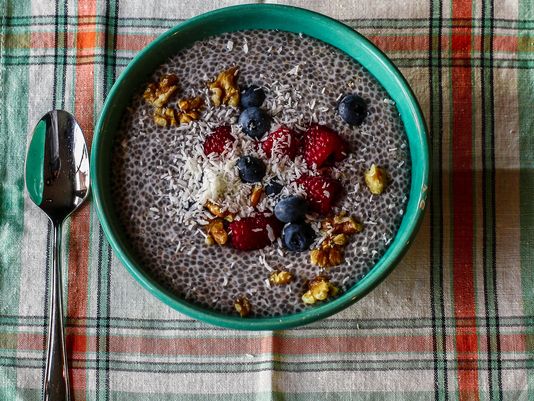Nancy Horn, owner of Dish Cafe and Catering and writer for the RGJ’s “Dish it Up” series, asked Carson Tahoe Health’s Registered Dietician, Kim Mason, for a nutritional analysis of one of her favorite healthy desserts. Check out the story below:
As a child of the ’70s, I watched those commercials for Chia Pets that aired during “The Monkees,” my legs crisscrossed on the red shag carpet in the cool rec room, mouth open, rapt, as time lapse showed the fresh green sprouts becoming the spikes on a porcupine or the fur on a dog.
I was intrigued, of course, and discussed the Chia Pet with my friends on the bus as it rumbled down the road to school. How did these sprouts grow, and how long until they were tall enough to cover the clay animal with a generous coat of green? What happened if the sprouts grew too long? Would you take up scissors and give the animal a trim? Were these green sprouts edible? Was this magic, like the sea monkey ads in the back of the comic books we begged for at the market?
Whatever this thing was, we all wanted one. Immediately. But we realized we’d all have to wait for a holiday, birthday or some kind of special occasion. Which totally bummed me out because I had a summer birthday and some of my friends were lucky enough to have a fall birthday and already had a Chia Pet. I watched these blasted pets sprout at their houses when we had sleepovers or visits.
My parents didn’t ever go for the Chia Pet because they’d said yes to the sea monkeys, and they figured that was enough. The sea monkeys turned out to be a bad choice and smelled like yeast. After months of watching for signs of the mermaid-like creatures to start swimming around in my fish bowl, I gave up and 86ed them into the sink. I clung to the hope that they’d find their kingdom in Lake Superior. Sigh.
Crunch and thicken
It’s been a long while since those carefree days. Now, Chia seeds are sprouting up in cookbooks and magazines across the country. It turns out these tiny black seeds are good for you. The seeds are ages old and were used by ancient peoples to boost their strength and endurance. Chia seeds are full of protein and fiber and are easy to store and use.
The tiny black seeds look like poppy seeds and can be added for crunch to salads, smoothies, hot cereals or almost any dish you can think of. Use them anywhere you’d use poppy seeds. And guess what? The seeds have a secret power: If you add liquid to them, they form a clear gel that acts as a thickener, resulting in a sort of tapioca texture.
I love using these black beauties in a chilled, creamy pudding or in a smoothie or shake, with the seeds suspended in milky deliciousness. If you’re baking and find yourself lacking an egg or two, Chia seeds can pinch hit for you. Just shake up the seeds in a jar with water (use a 1 to 6 six ratio of seeds to water) and refrigerate overnight. You’ll wake up to a jelly-like substance you can use as a stand in for an egg in your muffin batter. One tablespoon of Chia gel equals one egg. Isn’t that eggciting?
For Dad
Something else happened this past week that made me think of Chia seeds again. I took my Dad to a doctor’s appointment, and we spoke about adding more fiber, protein and hydration to his diet. My dad adores tapioca pudding, which we ate a lot of growing up, and I make it for him every now and then.
As we chatted with the doctor, I remembered Chia seeds and how Chia pudding would cover Dad’s nutritional needs and provide a scrumptious breakfast or dessert to savor, too. Plus, Dad was excited for me to make him some.
So, I give you this lovely Chia pudding recipe. Let me know what you think.
DISH IT UP CHIA PUDDING
5 cups plain or vanilla coconut milk or almond milk or a combination of the two or your favorite kind of milk (I love Trader Joe’s brand of coconut milk in the shelf stable boxes and Califia Farms Pure Almondmilk in the refrigerated section), divided
1/3 cup honey or your favorite sweetener (I love our local honey that you can find at grocery stores or the Great Basin Community Food Co-op)
1 cup Chia seeds (find them near the grains or in the health food section of the grocery store, sometimes in bulk)
1/2 teaspoon fine sea salt
1 teaspoon vanilla extract
1/2 teaspoon coconut extract or almond extract
I like to make this pudding in a big 8-cup glass liquid measuring cup with a spout. Pyrex makes a good one, and so does Pampered Chef (with a lid). You also can find beautiful colorful bowls at T.J.Maxx, Marshall’s, Tuesday Morning or Ross. Sometimes, the vessels are called batter bowls because they’re perfect for pancake or waffle batter. I use my big glass measuring cup for storing everything, especially soup.
Or, you can just use a mixing bowl. I’ve made half recipes of this pudding in a 32-ounce wide-mouth Mason jar, which makes for easy storage and for easy transport to someone who needs some Chia pudding.
This pudding comes together quickly, and the method is a snap. Gather your ingredients. Pour about 1 cup of the milk into the measuring cup or vessel and add the honey. Heat these up for a minute or two in the microwave. You’re just heating these ingredients so the honey can easily and evenly be blended into the milk. Stir with a whisk.
Add the remaining 4 cups of milk, Chia seeds, sea salt and both extracts. Whisk well to incorporate. Leave on the counter at room temperature for 30 minutes. Whisk again, cover and refrigerate to thicken.
The next day or at least 8 hours later, whisk again and taste. Adjust the seasonings, if you need to, by adding a little more salt or flavoring extract. Then, spoon the pudding into bowls and enjoy.
You can eat this pudding plain or add some toppings like unsweetened coconut, toasted nuts, fresh fruit like berries or sliced banana, real maple syrup, raw sugar or maple sugar. For breakfast, I love eating this dish with some of that unsweetened coconut and some of those berries and sliced bananas. I can attest this delicious, healthful pudding will fill you up fast. Plus, no guilt at all. Makes six 8-ounce servings.
Nutrition information per serving (without toppings): 309 calories (21 percent from fat, 14 percent from protein, 66 percent from carbohydrates); 11 g protein; 15.8 g tot fat; 1 g saturated fat; 0 g monounsaturated fat; 36 g carbohydrates; 3 g fiber; 28 g sugar; 177 mg calcium; 1 mg iron; 230 mg sodium; 0 mg cholesterol.
Image via







